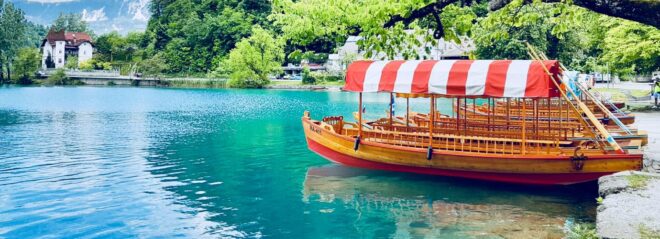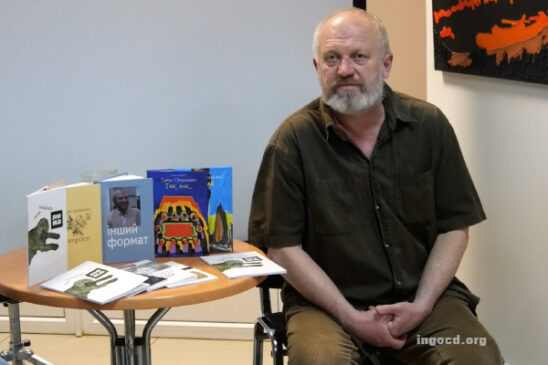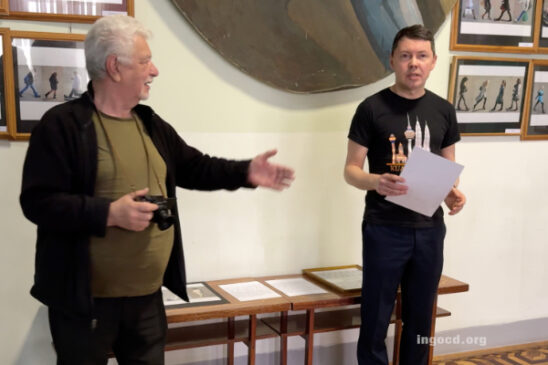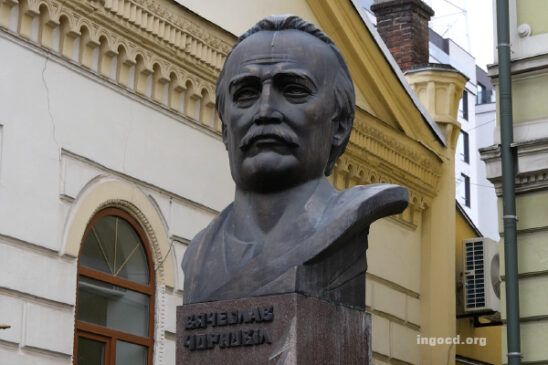Finland

1. The Finnish education system
- Equity in education
A key feature of the national education culture is to ensure equal opportunities for all. Individual support measures are in place to guarantee that every pupil and student can reach their full potential. Differences between schools are small and the quality of teaching is high all around the country. The education system does not have any dead-ends which would affect an individual’s learning career.
In Finland, education is publicly funded. Only two per cent of pupils in compulsory education attend schools that have a private provider. Also these schools are publicly funded and they cannot have any tuition fees.
Education from pre-primary to higher education, is free. School meals and all learning materials are provided free and access in remote and sparsely populated areas is ensured through free school transport.
- The education system is based on trust and responsibility
In Finland the provision of education is steered through regulations, information and funding. Local autonomy is high. Most of the funding comes from local budgets and the government transfers are not earmarked.
One of the regulations, the national core curriculum leaves room for local variations and therefore individual schools and teachers have a lot of freedom in designing their own curricula and instruction.
Also Finnish higher education institutions enjoy extensive autonomy. They are independent regarding their finances and administration. Institutions are autonomous regarding their teaching and research.
There is very little external control, such as school or textbook inspections. The first national examination takes place at the end of general upper secondary education. The most important quality assurance mechanism is the self-evaluation carried out by the education providers themselves. Nationally sample-based assessment are carried out according to an assessment plan. HE institutions are also expected to follow the quality of their operations and teaching.
- Life-long learning in focus
Life-long learning is ensured by making it possible for leaners to take up studies at any stage of their lives. Education for adults is provided at all levels of education. Also informal and non-formal education is recognised. In vocational education, for example, competence-based qualifications offer a way to demonstrate prior learning.
Adult learning is very popular. Different institutions arrange a great variety of courses and programmes for adults at all levels of formal education, and the provision of liberal adult education is extensive. Adult education includes self-motivated education, staff training and labour market training. It may lead to qualifications or be related to general self-development.
In 2017 over 27 per cent of Finnish adults participated in adult education compared to an EU average of 11 per cent. Most of this is non-formal education.
- Good learning outcomes are achieved at average expenditure.
The average costs per pupil or student are close to the average rates in the EU as well as OECD. In 2019 the average expenditure in USD per pupil was
| primary education | total secondary education | tertiary education
(including R&D) |
|
| Finland | 10 576 | 11 894 | 18 129 |
| EU22 average | 10 141 | 11 673 | 17 670 |
| OECD average | 9 923 | 11 400 | 17 559 |
Source: OECD Education at a Glance 2022
Of all public spending in Finland, 10.2% was used for education in 2021. Most of the total cost was spent on basic education. The biggest component is teaching, but for example in basic education the cost per pupil also comprises school, meals, school transport, health and welfare services.
2. Stages of the education system
ISCED 0
- early childhood education and care (varhaiskasvatus)
Participation in early childhood education and care is a universal right for all children under school age, that is, aged 0-6 years. It is mainly organised in day-care institutions and so-called family day-care. There are moderate fees for families.
- pre-primary education (esiopetus)
Compulsory pre-primary education stats one year before basic education at the age of six. Municipalities have to provide pre-primary education of a minimum of 700 hours per year. Generally this is organised so that the children have half a day of pre-primary education activities and the rest of the day is early childhood education and care. Pre-primary education is entirely free for the families.
ISCED 1-2
- single-structure primary and lower secondary education (perusopetus)
Comprehensive school education begins at the age of 7 and lasts for 9 years. It is provided in a single structure system. It includes grades 1-9. Education is free for pupils as well as learning materials, daily school meal, health and welfare services and transport from home to school if the way to school is long or dangerous.
ISCED 3
- upper secondary education (toisen asteen koulutus)
general upper secondary education (lukiokoulutus)
vocational upper secondary education (ammatillinen koulutus)
Upper secondary education is provided by general and vocational upper secondary institutions. The general age to participate in upper secondary studies is from 16 to 19 years. In vocational upper secondary education in particular many students are older.
ISCED 6-8
- higher education (korkeakoulutus)
university (yliopisto)
university of applied sciences (ammattikorkeakoulu)
Higher education is provided by universities and universities of applied sciences. The first are more academically oriented and the latter more professionally-oriented institutions. ISCED 8 level qualifications, such as doctorates can only be granted by universities.
3. Structure of the national education system
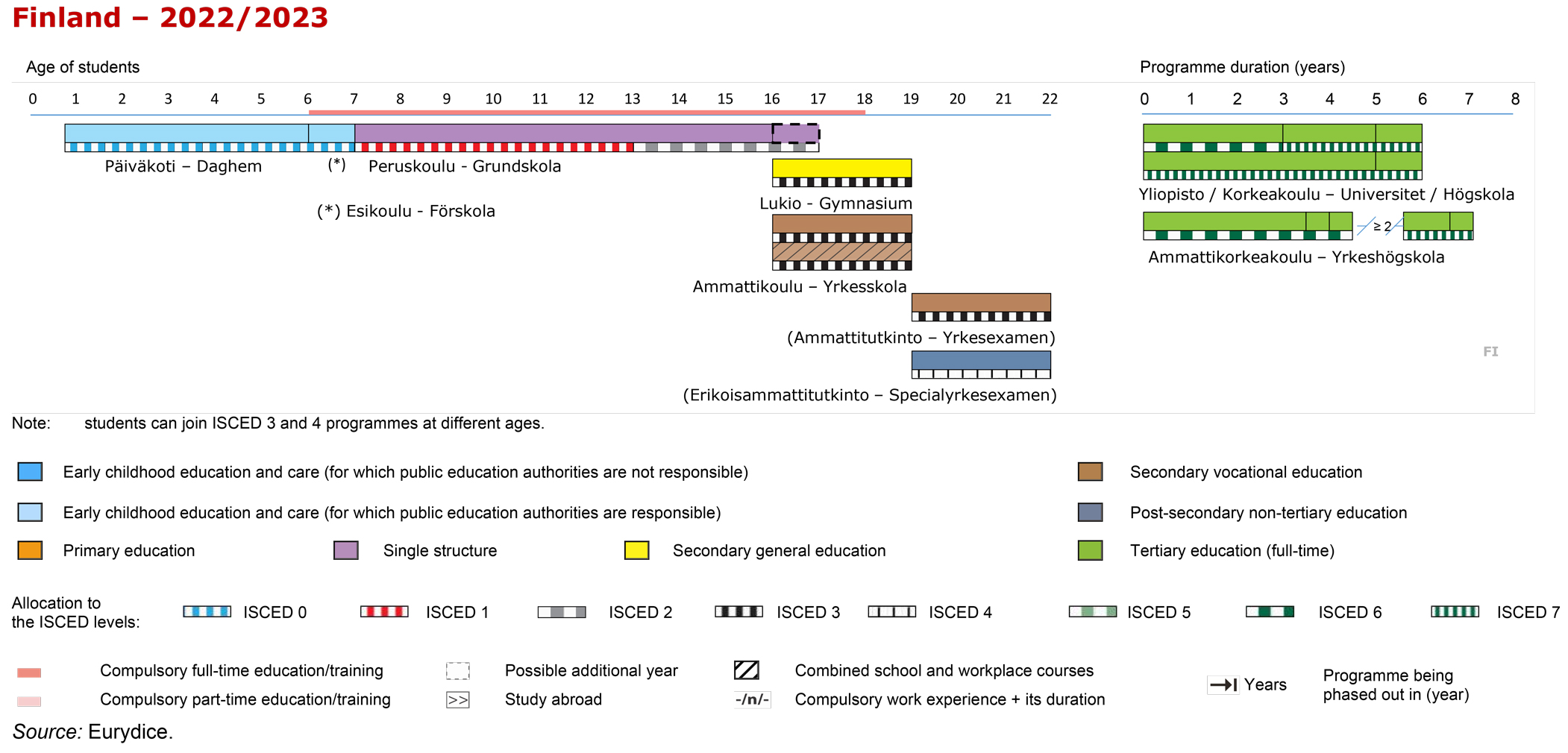
4. Useful links
For more information on Finnish education system
Ministry of Education and Culture
Finnish Education in a Nutshell
Statistics Finland – Education
The Association of Finnish Local and Regional Authorities – Education and culture
The Trade Union of Education in Finland, OAJ
Teacher education e.g. University of Helsinki – Department of Education
Common European reference tools provided by the Eurydice network
- National Student Fee and Support Systems
- Organisation of the Academic Year in Higher Education
- Organisation of School Time in Europe (Primary and general secondary education)
- Recommended Annual Instruction Time in Full-Time Compulsory Education in Europe (Presented by grades/stages for full time compulsory education as well as by subject and country.)
- Teachers and School Heads Salaries and Allowances in Europe (Salaries and allowances of teachers and school heads at pre-primary, primary, lower secondary and upper secondary education levels.)
Source: https://eurydice.eacea.ec.europa.eu/national-education-systems/finland/overview
Follow us on social media: Facebook, Twitter, Instagram, YouTube.



